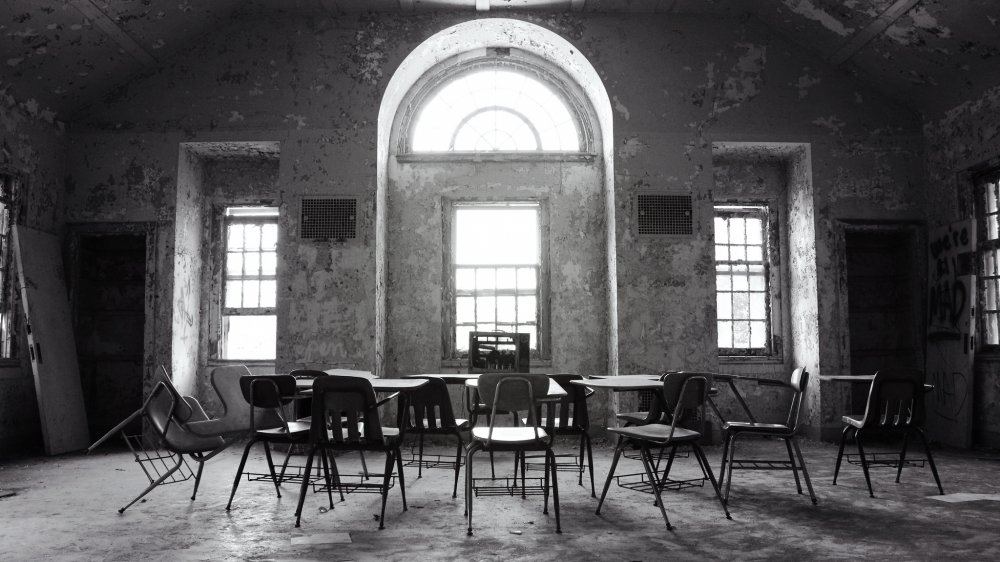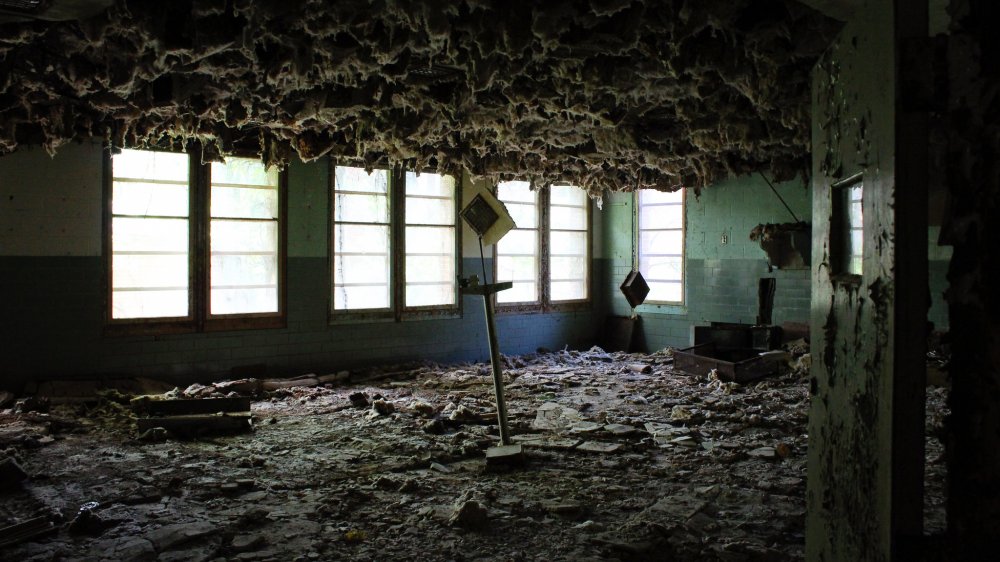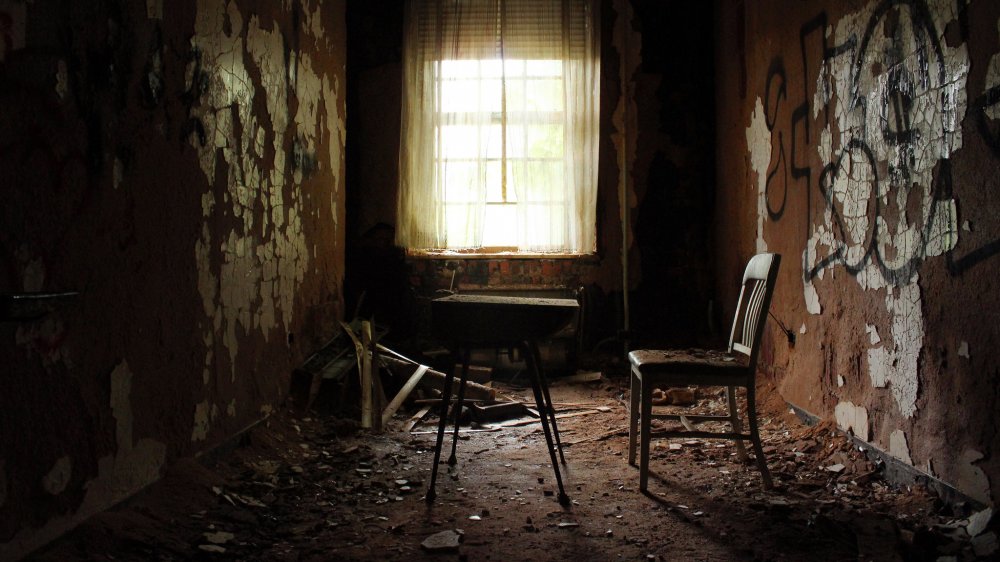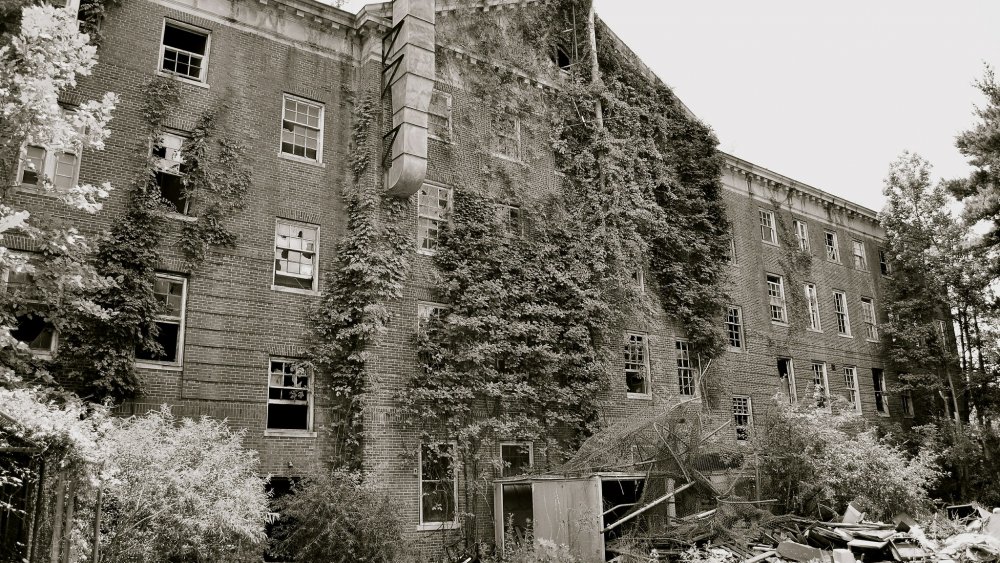The Disturbing Past Of Forest Haven Asylum
The US is littered with abandoned structures. Some of these spaces are entirely forgotten. Lost, their bones of brick and wood slowly return to the soil with barely a soul to Instagram their passing. Other structures are carefully curated and preserved, like a long-dead butterfly — pinned to cork, neatly labeled, and slowly doomed to fade under endless curious eyes. But a rare few abandoned structures jut raggedly from the earth, like an obscene finger gesture from the past. These places are still alive. They pulse with yesterday's horrors.
The Forest Haven Asylum is definitely that place.
In a corner of Laurel, Maryland — and just a quick drive out of DC — hides a 200-acre property. Wrapped up in thick forest, you'll find a vast compound. Peeling paint, the smell of rot, and at least a few decades of graffiti-flexing all vie for attention beside decaying medical equipment and slowly disintegrating patient records.
If you're a person who enjoys counting stuff in the kind of place that has a dental chair with built-in restraints, you'll tally over 30,000 square feet of floor space, 22 separate institutional buildings, and — because of course! — one oddly out-of-place gravestone. What went down here? Well, it's complicated and messy. A warning that this article describes abuse, and may not be for everyone.
The plan was to build a utopia
Humans have been building facilities to take care of other less mentally-stable humans for some time now. The earliest known use of asylums occurred in the 8th Century, when physicians in the Middle East began to treat people for a range of psychological conditions (including those always mysterious lady problems) in dedicated wards. These facilities have always been difficult and unsettling places.
Flash forward to the early 20th Century USA, and physicians were painfully aware that facilities for treating mentally ill people needed to be ... well... just a lot better. It was with a spirit of progressive optimism that the Forest Haven Asylum opened its doors for patients in 1925. As Vintage News reports, the new facility was built to provide a more enlightened approach to mental health care. The hope was that patients wouldn't feel judged or punished for their condition in this place. On the contrary, those admitted to the Forest Haven Asylum would be welcomed as valued contributors to a thriving farming community, where they'd have a chance to feel valued and included while also receiving cutting-edge treatment (presumably not involving leeches).
The Forest Haven Asylum was built to give hope to everyone who crossed its threshold, and a chance to flourish.
So, what happened?
According to Atlas Obscura, money happened — or more accurately, a distinct lack of it. By the 1960s, funding for this vast and ambitious institution began to dwindle. As cutbacks bit into the facility's profits, one-by-one those wholesome recreational activities gradually fell away. Staff became disgruntled. Skilled practitioners and care providers left, and a new workforce of under-skilled and poorly motivated staff took their place. And the biggest victims of this whole defunding tragedy were, of course, the patients. As The Line Up describes in The Misery of Forest Haven Asylum, by the time the turbulent '60s swaggered into view, the facility was "no longer a utopian society, but a place of disposal for the troubled, the unwanted, and the misdiagnosed."
With lack of resources came neglect, and neglect slowly morphed into blatant abuse. Doctors (many of them declared medically incompetent by the state of Maryland) left patients to languish in padded cell isolation. As DCist reports, then-director of the DC Department of Human Services gave an account of seeing "nude residents paraded outdoors to be hosed down by staff members." The asylum became a place of nightmare.
People died. No known records exist of precisely how many victims died from neglect at the Forest Haven Asylum, and deceased patients were hastily buried in a mass grave on the grounds. However, most sources agree the toll conservatively numbers in the hundreds.
Karma came knocking ... eventually
According to the previously-cited Line Up article, in February of 1976, the parents of an 18-year-old patient, Joy Evans, brought a class action lawsuit against Forest Haven Asylum. Evans had died in the facility's care, with horrific neglect injuries she likely sustained over months of prolonged mistreatment. Two years later, the case was settled, and part of the ruling determined that Forest Haven should be permanently closed, its admittees reassigned to (hopefully much better!) facilities across the state. Justice had been served.
Only, no not really. Eight years passed. Inexplicably, the Forest Haven Asylum continued operations with little outside interference. It was only in the mid-'80s that a spate of deadly pneumonia cases brought the asylum's neglect back into the public's gaze. Investigators found that patients were being fed while restrained in a lying down position, causing food to enter their lungs. The asylum shut its doors for good in 1991, after over three decades of institutionalized horror. Architectural Afterlife reports that over 380 people lie buried in a mass grave beneath that one single headstone in the asylum's slowly decaying grounds. It's unlikely the actual death toll will ever be known.
The prototypically creepy asylum is a vital part of our folklore. YouTube and television are packed to their digitized rafters with stories of one slowly decaying bedlam or another. The thing that separates Forest Haven Asylum is that this place is the real deal. All that stuff we shiver about happened here.
As one intrepid explorer reporting for Architectural Life put it, "while tracing these long corridors back and forth, you may still catch a sterile scent lingering in the air. Examining these spaces [immerses you] in the fragmented remains of entire past lives."



